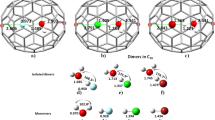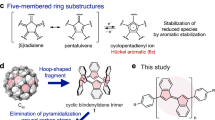Abstract
The diversity of molecular structures exhibited by fullerenes1 suggests a wide range of interesting and useful properties. Several fullerenes are now considered to be well characterized, but only minor variations in their chemical and physical properties have been observed2. Here we show that there are in fact two distinct classes of fullerenes, with some very different chemical properties. Members of the first class, typified by C60 and C70, have large energy gaps between the highest occupied and lowest unoccupied molecular orbitals (HOMO and LUMO), and are soluble in many organic solvents. The second, previously unrecognized class is represented by C74 and selected isomers of the higher fullerenes, such as that of C80 with icosahedral symmetry: these are either free radicals or have small HOMO–LUMO gaps. Like radical metallofullerenes, they are kinetically unstable and react readily to form insoluble, polymerized solids. These intermolecular bonds can be broken by electrochemical reduction. After reducing them to soluble anions, we have been able to isolate and characterize these new fullerenes.
This is a preview of subscription content, access via your institution
Access options
Subscribe to this journal
Receive 51 print issues and online access
$199.00 per year
only $3.90 per issue
Buy this article
- Purchase on Springer Link
- Instant access to full article PDF
Prices may be subject to local taxes which are calculated during checkout




Similar content being viewed by others
References
Fowler, P. W. & Manolopoulous, D. E. An Atlas of Fullerenes (Clarendon, Oxford, (1995)).
Dresselhaus, M. S., Dresselhaus, G. & Eklund, P. C. Science of Fullerenes and Carbon Nanotubes (Academic, San Diego, (1996)).
Kratschmer, W., Lamb, L. D., Fotiropoulos, K. & Huffman, D. Solid C60: a new form of carbon. Nature 347, 354–356 (1990).
Taylor, R., Hare, J. P., Abdul-Sada, A. & Kroto, H. W. Isolation, separation and characterization of the fullerenes C60and C70: The third form of carbon. J. Chem. Soc., Chem. Commun. 20, 1423–1425 (1990).
Diederich, F. & Whetten, R. L. Beyond C60: The higher fullerenes. Acc. Chem. Res. 25, 119–126 (1992).
Kikuchi, K. et al. Isolation and identification of fullerene family: C76, C78, C82, C84, C90and C96. Chem. Phys. Lett. 188, 177–180 (1992).
Saito, S., Okada, S., Sawada, A. & Hamada, N. Common electronic structure and pentagon pairing in extractable fullerenes. Phys. Rev. Lett. 75, 685–688 (1995).
Weaver, J. H. et al. Electronic structures of solid C60: Experiment and theory. Phys. Rev. Lett. 66, 1741–1744 (1991).
Hino, S., Kikuchi, K. & Achiba, Y. Photoelectron spectra of higher fullerenes and their potassium complexes. Synth. Metals 70, 1337–1340 (1995).
Yang, Y. et al. Reversible fullerene electrochemistry: correlation with the HOMO-LUMO energy difference for C60, C70, C76, C78, and C84. J. Am. Chem. Soc. 117, 7801–7804 (1995).
Liu, X., Schmalz, T. G. & Klein, D. J. Favorable structures for higher fullerenes. Chem. Phys. Lett. 188, 550–554 (1992).
Zhang, B. L., Wang, C. Z., Ho, K. M. & Chan, C. T. The geometry of large fullerene cages: C72to C100. J. Chem. Phys. 98, 3095–3102 (1993).
Xu, Z., Nakane, T. & Shinohara, H. Production and isolation of Ca@C82(I–IV) and Ca@C84(1–II) Metallofullerenes. J. Am. Chem. Soc. 118, 11309–11310 (1996).
Cummins, T. R. et al. Electronic states and molecular symmetry of the higher fullerene C80. Chem. Phys. Lett. 261, 228–233 (1996).
Nakao, K., Kurita, N. & Fujita, M. Ab initio molecular-orbital calculation for C70and seven isomers of C80. Phys. Rev. B 49, 11415–11420 (1994).
Kobayashi, K., Nagase, S. & Akasaka, T. Atheoretical study of C80and La2@C80. Chem. Phys. Lett. 245, 230–236 (1995).
Beer, F., Gugel, A., Martin, K., Rader, J. & Mullen, K. High-yield reactive extraction of giant fullerenes from soot. J. Mater. Chem. 7, 1327–1330 (1997).
Chai, Y. et al. Fullerenes with metals inside. J. Phys. Chem. 95, 7564–7568 (1991).
Wang, L. S. et al. The electronic structure of Ca@C60. Chem. Phys. Lett. 207, 354–359 (1993).
Boltalina, O. V., Ioffe, I. N., Sorokin, I. D. & Sidorov, L. N. Electron affinity of some endohedral lanthanide fullerenes. J. Phys. Chem. 101, 9561–9563 (1997).
Suzuki, T. et al. Electrochemical properties of fullerenolanthanides. Tetrahedron 52, 4973–4982 (1996).
Hummelen, J. C., Knight, B., Pavlovich, J., Gonzalez, R. & Wudl, F. Isolation of the heterofullerene C59N as its dimer (C59N)2. Science 269, 1554–1556 (1995).
Gromov, A., Kratschmer, W. & Campbell, E. Extraction and HPLC purification of Li@C60/70. Chem. Commun. 20, 2003–2004 (1997).
Pekker, S. et al. Single-crystalline (KC60)n: A conducting linear alkali fulleride polymer. Science 265, 1077–1078 (1994).
Yeretzian, C. et al. Partial separation of fullerenes by gradient sublimation. J. Phys. Chem. 97, 10097–10101 (1993).
Koh, W., Dubois, D., Kutner, W., Jones, M. T. & Kadish, K. M. Simultaneous cyclic voltammetry and electrochemical quartz crystal microbalance studies of buckminsterfullerene (C60) film electrodeposition and tetra-n-butylammonium electrodoping in acetonitrile. J. Phys. Chem. 96, 4163–4165 (1992).
Xie, Q., Perez-Cordero, E. & Echegoyen, L. Electrochemical Detection of C606− and C706−: Enhanced stability of fullerides in solution. J. Am. Chem. Soc. 114, 3978–3980 (1992).
Frisch, M. J. et al. Gaussian 94, Rev. E.1 (Gaussian, Inc., Pittsburgh, PA, (1995)).
Green, W. H. J et al. Electronic structures and geometries of C60anions via density functional calculations. J. Phys. Chem. 100, 14892–14898 (1996).
Weaver, M. J. & Gao, X. Molecular capacitance: Sequential electron-transfer energetics for solution-phase metallic clusters in relation to gas-phase clusters and analogous interfaces. J. Phys. Chem. 97, 332–338 (1993).
Haddon, R. C. Chemistry of the fullerenes: the manifestation of strain in a class of continuous aromatic molecules. Science 26, 1545–1550 (1993).
Acknowledgements
We thank W. Bell, R. Cook, S. Dietz and J. Wright at TDA Research, L. Wilson at Rice University, and K. Veirs at LANL for productive technical discussions. This work was funded by a NSF SBIR grant to J.M.A.
Author information
Authors and Affiliations
Supplementary Information
Rights and permissions
About this article
Cite this article
Diener, M., Alford, J. Isolation and properties of small-bandgap fullerenes. Nature 393, 668–671 (1998). https://doi.org/10.1038/31435
Received:
Accepted:
Issue Date:
DOI: https://doi.org/10.1038/31435
This article is cited by
-
Synthesis, Crystal Structure, Hirshfeld Surface Analysis, Molecular Docking, IR Spectroscopy and DFT Calculations of a Novel 2D Layered Hybrid Compound (C6H10N3O)2Cu2Cl6
Journal of Cluster Science (2023)
-
Endohedral metallofullerenes Mn@C60 (M = Mn, Co, Ni, Cu; n = 2–5) as electrocatalysts for oxygen reduction reaction: a first-principles study
Journal of Materials Science (2020)
-
Enhanced Photovoltaic Performance of Hybrid Solar Cells with a Calcium Interfacial Metal Electrode
Journal of Electronic Materials (2019)
-
Crystalline functionalized endohedral C60 metallofullerides
Nature Communications (2018)
-
Investigation of the influence of Br- and As-doped silica single-wall nanotubes: Hartree–Fock method
Bulletin of Materials Science (2018)
Comments
By submitting a comment you agree to abide by our Terms and Community Guidelines. If you find something abusive or that does not comply with our terms or guidelines please flag it as inappropriate.



